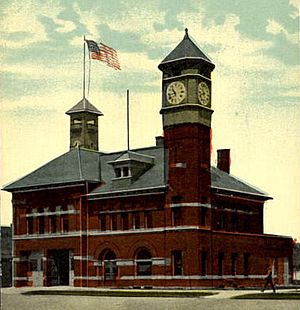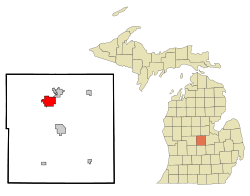Alma, Michigan facts for kids
Quick facts for kids
Alma, Michigan
|
|
|---|---|

Alma City Hall
|
|

Location of Alma, Michigan
|
|
| Country | United States |
| State | Michigan |
| County | Gratiot |
| Area | |
| • Total | 6.05 sq mi (15.67 km2) |
| • Land | 5.89 sq mi (15.26 km2) |
| • Water | 0.16 sq mi (0.41 km2) |
| Elevation | 735 ft (224 m) |
| Population
(2010)
|
|
| • Total | 9,383 |
| • Estimate
(2019)
|
8,890 |
| • Density | 1,508.83/sq mi (582.56/km2) |
| Time zone | UTC-5 (Eastern (EST)) |
| • Summer (DST) | UTC-4 (EDT) |
| ZIP codes |
48801-48802
|
| Area code(s) | 989 |
| FIPS code | 26-01540 |
| GNIS feature ID | 0620002 |
Alma is the largest city in Gratiot County in the U.S. state of Michigan. The population was 9,383 at the 2010 census. It was incorporated as the Village of Alma in 1872 and became a city in 1905.
Alma hosts the annual Highland Festival on Memorial Day weekend. It brings members of Scottish clans and interested onlookers together for a weekend of Highland dancing, bagpipes, kilts, and camaraderie.
Alma College, a small liberal-arts institution of approximately 1,300 students, is located in town and focuses on multidisciplinary learning in a residential setting.
Alma is the birthplace of both the modernist architect Ralph Rapson and writer/composer/lyricist Dan Goggin (Nunsense).
Alma was the home of Leonard Refineries which sold gasoline and other petroleum products throughout the lower peninsula of Michigan from its founding in 1936 until about 1966.
Contents
Geography
According to the United States Census Bureau, the city has a total area of 6.09 square miles (15.77 km2), of which 5.93 square miles (15.36 km2) is land and 0.16 square miles (0.41 km2) is water.
History
Alma was founded in 1853 by Ralph Ely. Perhaps first known for the Alma Springs Sanitarium, built and promoted in the 1880s by millionaire lumberman and capitalist Ammi Willard Wright, it achieved its greatest prominence nationally in the 1910s and 1920s as home of the Republic Motor Truck Company, briefly the largest exclusive truck manufacturer in the world. In 1953 Alma became the first place that high-octane gas, 96 octane, was produced.
Demographics
| Historical population | |||
|---|---|---|---|
| Census | Pop. | %± | |
| 1870 | 402 | — | |
| 1880 | 437 | 8.7% | |
| 1890 | 1,655 | 278.7% | |
| 1900 | 2,047 | 23.7% | |
| 1910 | 2,757 | 34.7% | |
| 1920 | 7,542 | 173.6% | |
| 1930 | 6,734 | −10.7% | |
| 1940 | 7,202 | 6.9% | |
| 1950 | 8,341 | 15.8% | |
| 1960 | 8,978 | 7.6% | |
| 1970 | 9,611 | 7.1% | |
| 1980 | 9,652 | 0.4% | |
| 1990 | 9,034 | −6.4% | |
| 2000 | 9,275 | 2.7% | |
| 2010 | 9,383 | 1.2% | |
| 2019 (est.) | 8,890 | −5.3% | |
| U.S. Decennial Census | |||
2020 census
As of the census[2] of 2020, there were 9,488 people, 3,519 households, and 2,033 families living in the city. The population density was 1,583.4 inhabitants per square mile (610.9/km2). There were 3,784 housing units at an average density of 638.1 per square mile (246.4/km2). The city's racial makeup was 95.0% White, 2.8% African American, 0.7% Native American, 0.6% Asian, and 0.9% from two or more races. Hispanic or Latino of any race were 9.1% of the population.
There were 3,519 households, 33.3% were married couples living together, 37.7% had a female householder with no husband present, 19.6% had a male householder with no wife present, and the average family size was 2.68
The median age in the city was 30.8 years. 18.2% of residents were under the age of 18, and 17.1% were 65 years of age or older. The gender makeup of the city was 48.9% male and 52.1% female. The median income for a household in the city was $36,408; about 24.7% of the population were below the poverty line, including 34.7% of those under age 18 and 12.4% of those age 65 or over. The employment rate in the city is 54.2%.
2010 census
As of the census of 2010, there were 9,383 people, 3,468 households, and 2,033 families living in the city. The population density was 1,582.3 inhabitants per square mile (610.9/km2). There were 3,784 housing units at an average density of 638.1 per square mile (246.4/km2). The racial makeup of the city was 92.8% White, 0.9% African American, 0.6% Native American, 0.8% Asian, 2.8% from other races, and 2.2% from two or more races. Hispanic or Latino of any race were 8.1% of the population.
There were 3,468 households, of which 30.8% had children under the age of 18 living with them, 38.4% were married couples living together, 15.2% had a female householder with no husband present, 5.0% had a male householder with no wife present, and 41.4% were non-families. 34.7% of all households were made up of individuals, and 14.8% had someone living alone who was 65 years of age or older. The average household size was 2.30 and the average family size was 2.92.
The median age in the city was 30.8 years. 21.4% of residents were under the age of 18; 21.3% were between the ages of 18 and 24; 21.1% were from 25 to 44; 20.7% were from 45 to 64; and 15.6% were 65 years of age or older. The gender makeup of the city was 46.9% male and 53.1% female.
Transportation
 US 127
US 127


 Bus. US 127
Bus. US 127 M-46
M-46- Public bus transportation is provided on a dial-a-ride service basis by the Alma Transit Center from 7:00 a.m.-8:00 p.m. during weekdays. The transportation service is available for Alma, St. Louis, Ithaca and Pine River Township.
</ref>
- General aviation services are available at Gratiot Community Airport, located about 3 miles southwest of the city.
Climate
This climatic region is typified by large seasonal temperature differences, with warm to hot (and often humid) summers and cold (sometimes severely cold) winters. According to the Köppen Climate Classification system, Alma has a humid continental climate, abbreviated "Dfb" on climate maps.
Notable people
- Keegan Akin, professional baseball player, born in Alma
- Dan Goggin, actor and writer (Nunsense)
- Louisa Boyd Yeomans King, gardener and author; lived c. 1902–1927
- Betty Mahmoody, author of Not Without My Daughter; born in Alma
- Kevin Puts, 2012 Pulitzer Prize winner for music; grew up in Alma
- Ralph Rapson, modernist architect; born in Alma
See also
 In Spanish: Alma (Míchigan) para niños
In Spanish: Alma (Míchigan) para niños

